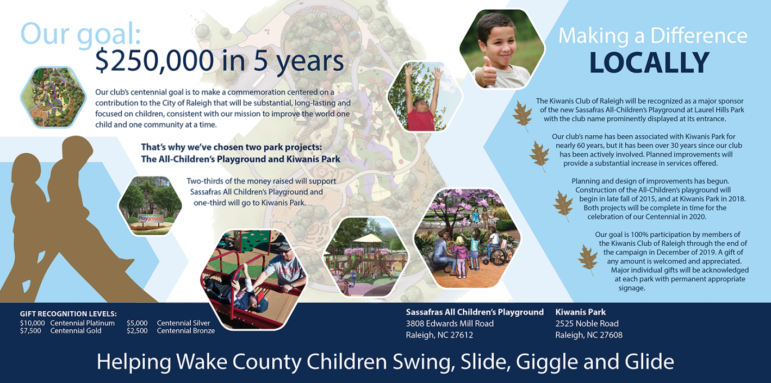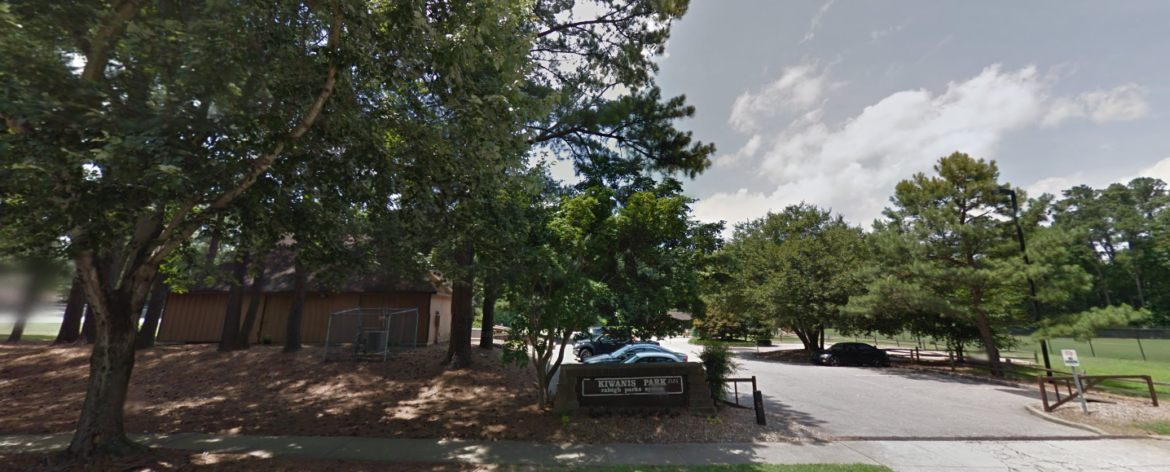Brought to you by Rufty-Peedin Design Build
Friday, May 27, 2016
On October 28, 1955, two weeks before Hill Valley’s clock tower was struck by a bolt of ruinous lightning, the Kiwanis Club of Raleigh entered into an agreement with the City’s Parks Department to fund the development of the 28-acre Kiwanis Park.
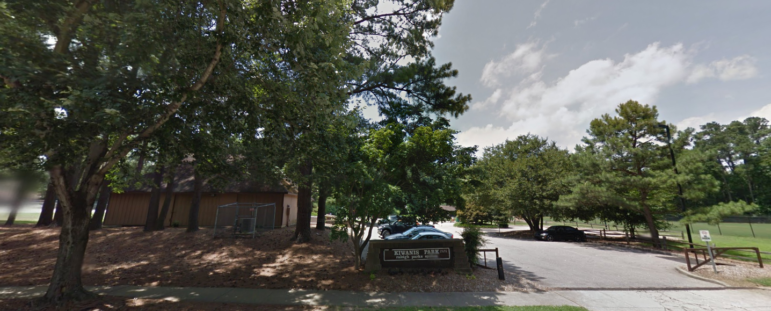
Google Maps
Kiwanis Park
Nearly 50 years later, Raleigh residents approved a 2014 parks and recreation bond referendum that provided about $700,000 in funding for an upgrade of Kiwanis Park.
Located in north-ish Raleigh near the intersection of Wake Forest and Six Forks, the park offers a number of amenities, including a neighborhood center, a picnic shelter, a basketball court and more.
Anyone who’s ever spent time browsing the City’s parks website is probably familiar with the little call-to-action that accompanies each park’s description. For Kiwanis? “Slide and climb on the playground or shoot a game of hoops on the basketball courts.”
Awfully tempting. It’ll be a wonder if the eventual contractors manage to get any work done, with distractions like that.
Speaking of contractors, on May 3, 2016, the City of Raleigh put out a request for qualifications for an architectural/engineering team to design and oversee the park’s planned renovation. Here’s how the work is described:
Funding of $700,000 for the Center renovation and site improvements was approved in the 2014 parks bond referendum. Other Capital Improvement funds are planned for a new playground, comfort station, and picnic shelter.
Well, this is a design solicitation after all, so you can’t exactly expect them to lay out in detail the upgrade plans, because those plans are what the City is presently soliciting.
According to the RFP documents, the design stage of the project is expected to last about 10 months, with bidding set to happen sometime around May 2017.
In a move that I’m sure would make Councilor Dickie Thompson happy, the City does appear to have plans to do a hard bid for this job, which means the work gets awarded to the lowest bidder. Thompson had previously criticized the use of a Construction Manager At Risk process for the Moore Square Park project, arguing, among other things, that it was too costly.
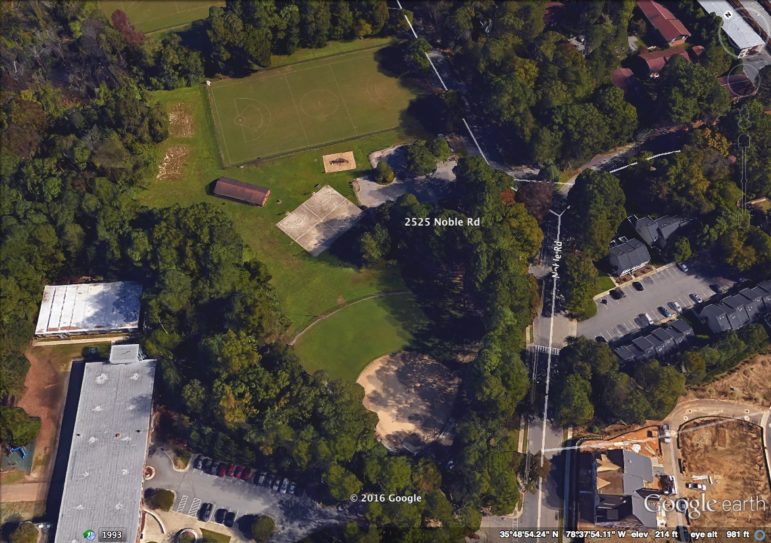
Google Earth
An overview of the park
The design proposals, due back to the City on June 2, 2016, will be graded on a number of factors, including team organization and structure, Green Building and Low Impact Development experience and the overall attractiveness of the project personnel team.
Beyond general renovations to the existing community center, which was originally built in 1974, and some site improvements, it doesn’t appear that the specific details of the renovation have been hammered out. One of the requirements listed in the design RFP was that at least one public input session be held, which we imagine will give neighbors an opportunity to offer some input on the project.
The session is described as allowing the designers the opportunity to “identify problems and alternatives.” The exact format of the meeting will be left up to the design consultant; suggested options include an open house, a small workshop and “Internet-based discussion.”
When one thinks of ideal places to hold rational, civil discourse about a project being funded with their tax dollars, the Internet probably isn’t the first thing to come to mind. I can’t imagine the winning RFP will include plans to do an AMA on Reddit or a Q&A on Twitter, although I think the latter could be pretty funny if the right people participated.
Funny though; not productive. There’s a lot to be said for in-person meetings: it’s much easier to talk to your neighbors about these kind of things in a pleasant, public setting where people are more engaged not just with each other, but the design team as well.
But that’s all in the future. Before we close out for the week, let’s take a quick look at the park’s past.
First though, a bit about the Kiwanis Club: A civic service organization, the club derived its name from the Otchipew Indian expression “Nunc Keewanis”, which means “self-expression” or “to make oneself known” and can be interpreted as “We Have a Good Time; We Make a Noise; We Trade; We Advertise”. This is all according to “A Short History of the Kiwanis Club of Raleigh” by John C. Brantley III. I wonder if he’s friends with William N. Finley IV.
The Club was founded in Detroit in 1915, and made its way to Raleigh a scant four years later, when “a small and progressive group of civic‐minded men held an informal meeting about December 5, 1919.”
According to Brantley, a publication named “The Raleigh Kiwanian” published in April 1950 an article about the 30th anniversary celebration for the club. Per the Kiwanian: “The banquet, held at the old Country Club, was indeed a splendid occasion. There were speeches galore, music, favors, horseplay, and a touch of pathos. All stags were seated in a chicken‐wire enclosure labeled “Tough Old Birds.” Appreciating fully this rather heavy‐handed piece of wit, the rest of the members saw to it that the “birds” remained in their temporary prison.”
These guys know how to have a good time!
Five years later, the Club entered into an agreement with the City of Raleigh to develop the Kiwanis Park. The first item funded, apparently was lighting for the baseball field, which cost $2,950. In today’s money, that would’ve been about $26,000.
The lights were followed by bleacher seating and an outfield fence, and the Club went on to sponsor the Little League program there from the 1950s through the 1990s, when the City of Raleigh took over.
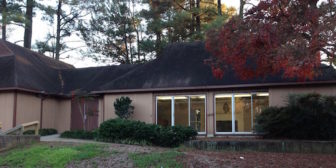
City of Raleigh
The community center at Kiwanis Park
In 1968, thirteen years after the initial agreement, the Club agreed to “provide up to $10,000 for continuing development of Kiwanis Park.” Apparently, flooding from Crabtree Creek meant not much else had been developed beyond the baseball field. In November of that year, $3,000 was spent on “three all-weather tennis courts and public restrooms at the park.”
The community center at the park was built by the City in the early 70s, and held its official opening on July 26, 1974. Five years later, the Club donated more money to the park, this time for the construction of a soccer field. Brantley estimated that the club had spent about $20,000 on the park through that time.
Since then, the club has not had a lot of direct involvement with the development of the park, although it is currently in the midst of a fundraising campaign that aims to raise $250,000 over five years for the Sassafras All-Children’s Playground at Laurel Hills Park and general improvements at Kiwanis Park. The playground will receive the majority (2/3) of the funds raised.
